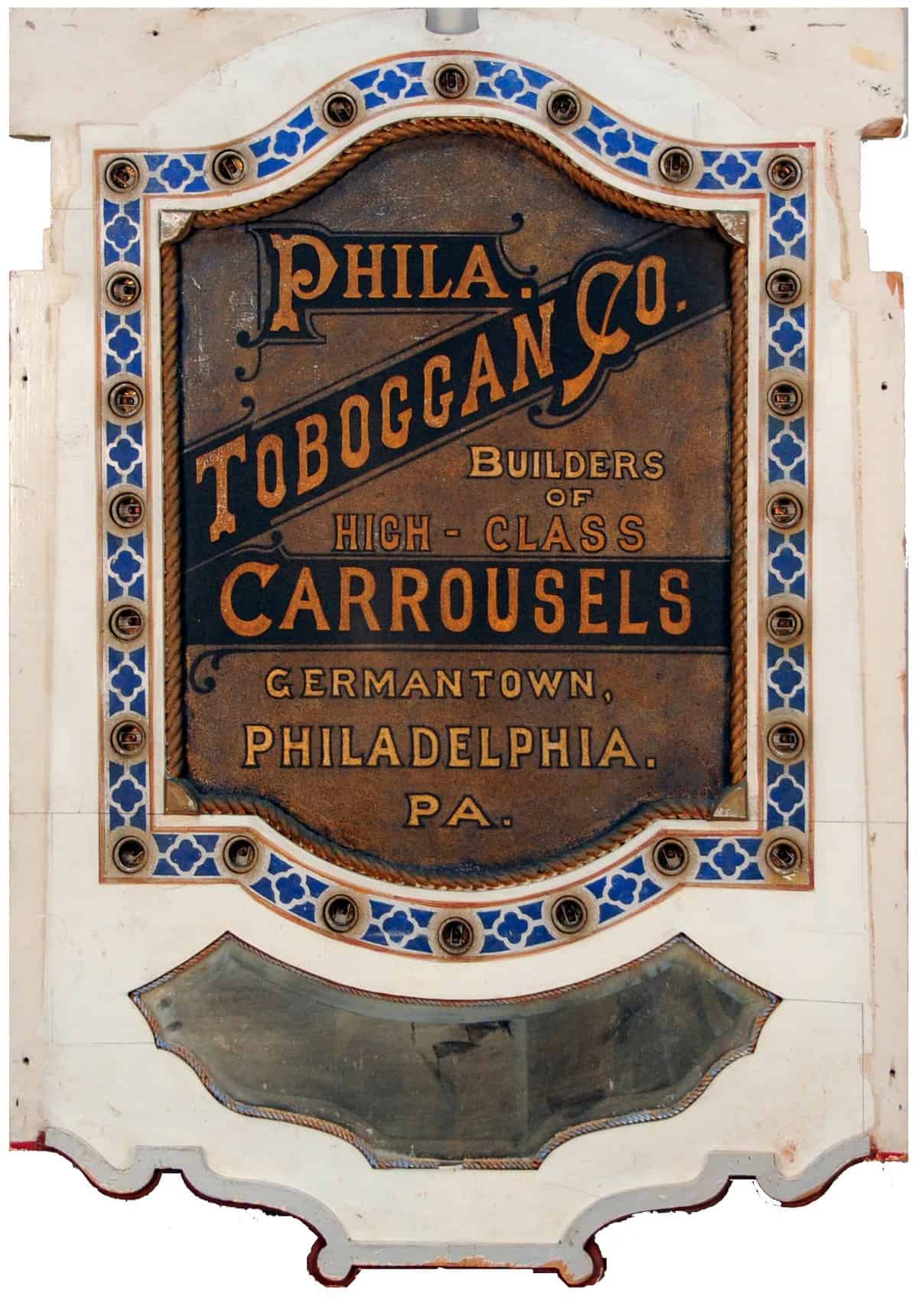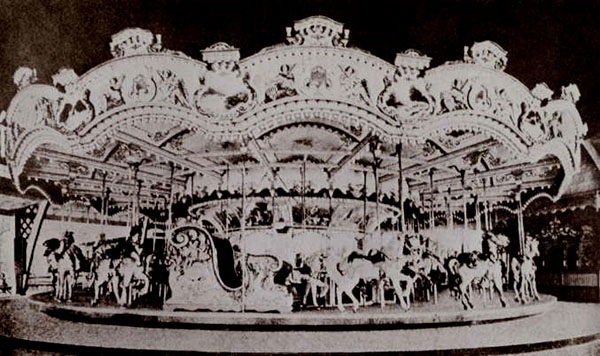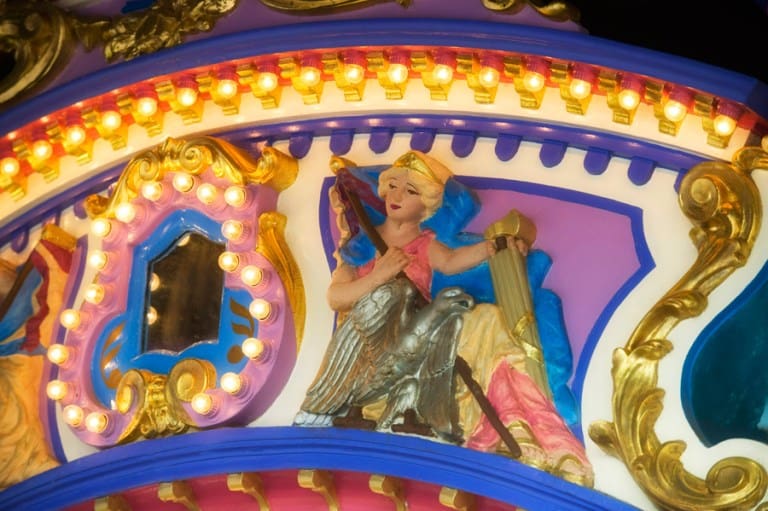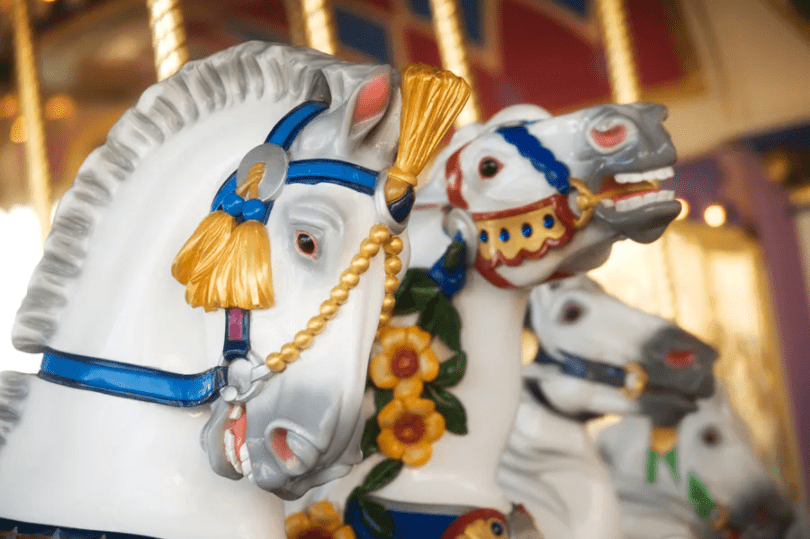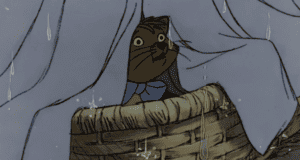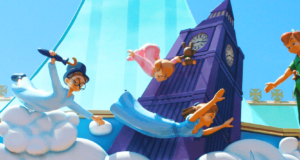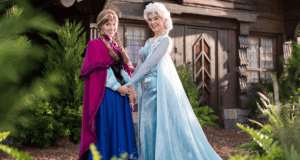
While designing areas of Disney parks and resorts, Disney Imagineers often find antique items to help create the most immersive environments possible. Sometimes these antiques come in the form of entire attractions! The oldest attraction at Walt Disney World can be found right in Fantasyland at the Magic Kingdom: Prince Charming Regal Carrousel.
The carrousel Guests ride in the Magic Kingdom was originally constructed in 1917, six years before the Walt Disney Company was even founded. (True Disney history buffs may know that the earliest locomotives on the Walt Disney World Railroad date back to 1916, but those were not built as an attraction. Rather, they were purchased and refurbished by Disney for use in the parks, making the carrousel truly the oldest attraction.)
The carrousel was built by the Philadelphia Toboggan Company, one of the oldest amusement ride manufacturers, for the Detroit Palace Garden Park in Detroit, Michigan. (The park went by a number of names during its history, you may also see it referred to as Electric Park, Riverview Park, Luna Park, or Granada Park.)
As you have probably guessed then, the carrousel was not originally themed to Cinderella. While the original fairytale existed, Disney’s retelling as an animated film would not be produced until 33 years later on February 15, 1950. When the carrousel was first constructed, the ride had a Patriotic scheme and worked with a primarily red, white, and blue color palette, fitting for its name at the time as “Miss Liberty,” or “The Liberty Carousel.”
In the mid-1920s, the Detroit Palace Garden Park suffered a number of financial difficulties that ultimately resulted in the park declaring bankruptcy and closing in 1928. As pieces of the park were sold off, Miss Liberty was sold to the owners of a park on the East Coast, and after brief refurbishment, the carousel opened to Guests at the Olympic Park in Maplewood, New Jersey.
Olympic Park opened in 1887, and was a well-known amusement park by the time the carrousel was moved there in 1929. The park was known as a popular place for summer tourists and locals, not only for its rides but for having the largest public swimming pool in the region, plus spaces for live music, dancing, horse races, and more.
But, like the Detroit Palace Garden Park, and many amusement parks in the pre-Disneyland world, operating such a business was a risky enterprise. In 1912, a fire destroyed the dance hall and a couple of other buildings at Olympic Park, and where operating margins were already so slim while purchasing new attractions and enticing visitors to return to the park (and where in New Jersey, it was only a seasonal operation), the owners fell into lots of debt. The summer after the fire was one of the worst in terms of weather in recent history, so the park lost some of its operating time that was badly needed to make up the funds lost to the fire.
Over the next decade, the park changed hands a number of times, with each new owner hoping to fix the poor financial state of the park. Unfortunately, each time the park changed hands, issues continued to slip through the cracks, and the legacy of debt remained.
During the prohibition era, Olympic Park went dry, which caused another financial blow. By the end of the 1920s, the park was just finding some success in focusing on a family-friendly experience. By then, the opera house had been remodeled into a funhouse, and ticket prices were lowered to attract Guests with families to the parks. The swimming pool was under construction, and the especially family-friendly ice cream palace was ready to welcome Guests back to the park.
In keeping with the family-friendly attractions, the park purchased the carrousel in 1928. Within the same year, a more extensive refurbishment was done on the attraction, giving the ride an imported Italian organ that came adorned with dancing figurines, drums, and a symbol.
Then, just when things were starting to improve for Olympic Park, the Great Depression hit causing a severe decline in attendance. The park had a brief period of certainty during the late 1930s, but once World War II started the financial problems only worsened. With rations on food items making restaurant purchases challenging, and manufacturing parts often being unavailable due to the war effort, a number of restaurants had to close and some attractions remained closed as well where they were unable to be repaired.
After the war, attendance began to rise again leveling off at respectable numbers in 1948-49. At this time, the park finally began to expand under the assumption that additional attractions would help boost attendance even further. The focal point of the attraction was the area around the carrousel that was set to be converted into an entire Kiddieland area.
Unfortunately, the financial difficulties returned in 1950, this time taking the direction of the park eventually toward its permanent closure. 1950 brought on multiple hurricanes that severely impacted the New Jersey area, and left the park’s two rollercoasters completely destroyed. The hurricanes left Olympic Park with $225,000 worth of damages, with $100,000 of that coming from just the loss of the rollercoasters alone.
It took years to rebuild and get the park ready for a new season, and after more changes in ownership, the park was finally ready for its 1964 season. In a very strange turn of events, a group of hundreds of teenagers overtook the park on opening day essentially destroying everything in their path. They stole merchandise, destroyed midway games, and broke whatever they could. The group then continued on to neighborhoods near the park, causing locals to associate the group with the park itself, resulting in another year of low attendance and debts paying for damages.
When the park closed at the end of the 1964 season, the owners announced that the park would not reopen. The plan was to sell the land to a real estate company, however, the deal fell through and the park sat abandoned for 13 years before the land was finally redeveloped.
In 1967, pieces of the park that were still usable were being sold off, and the Walt Disney Company purchased the carrousel. The carrousel that would eventually find its permanent home in the Magic Kingdom is one of the largest ever made by the Philadelphia Toboggan Company running 60 ft. in diameter.
The company created 89 merry-go-rounds proper to the Great Depression (Disney’s is number 46), and it is believed that less than 12 still exist today, so when you ride Prince Charming Regal Carrousel in the Magic Kingdom, you are truly experiencing a unique piece of amusement park history!
To fit the theme of the Magic Kingdom, the carrousel underwent a massive refurbishment, adding thematic elements from Cinderella (1950) and refurbishing each horse individually including unique details like 23 karat gold leaf paint, along with silver and bronze to create the ultimate royal color scheme.
While most of the carrousel is unrecognizable as “The Liberty Carousel” today, if you look up and toward the center of the carrousel while you are riding (it is difficult to see without being on the attraction) you will see some of the original gold eagles and patriotic elements carved and illustrated on the ride’s center frame. From the outside of the carrousel the maidens carved into the ride’s awning blend into the Cinderella theme now, but you can easily imagine them alongside a red, white, and blue facade. You can also find artwork of Eagles, Native Americans, and other hints to the ride’s prior theming if you look closely at some of the horses.
When the Magic Kingdom opened, the ride was called “Cinderella’s Golden Carousel,” however in 2010, the name was changed to “Prince Charming Regal Carrousel.” In addition to switching to the French spelling of “carrousel” with the extra R, the name change implies the ride’s backstory as a training device for jousting of carved horses that belonged to the Prince and later captured the attention of the townspeople causing Prince Charming to construct a second carrousel near Cinderella Castle for all to enjoy.
And there you have it– Walt Disney World may be celebrating its 50th anniversary right now, but the oldest attraction at the resort is over 100 years old!

